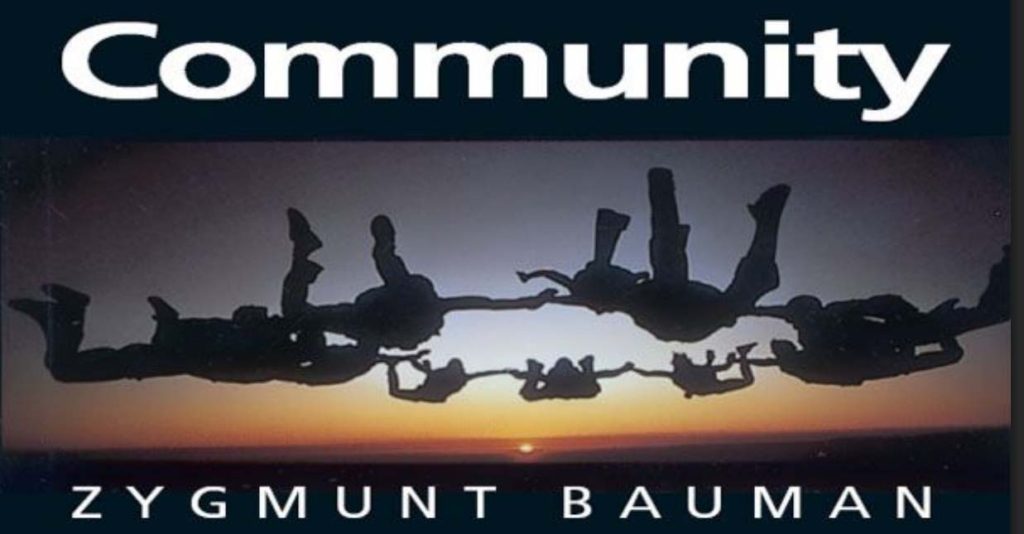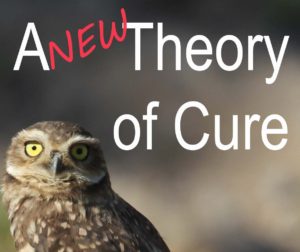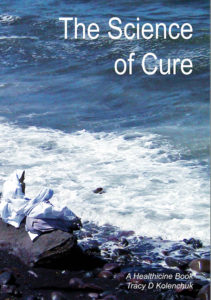To have, or to be, that is the question. Do communities have spirits? Or are they spirits?

Image from the book by Zygmunt Bauman.
What is a community? What is “not” a community? Is there a “black community” in the USA? Or are there many black communities, or none? Is there a Muslim community? A Jewish community? Are anthills and beehives communities? What about trees?How small can a community be, and still be a community? A family is a community, right? An extended family? A couple? A single person? How big can a community be, and still be a community? Is life on the planet earth a community?
Am I a community? Are you a community? Are “me, myself, and I” a community?
Individuals Live in Communities
Communities consist of individuals, living individuals. A group of rocks, or mountains, or planets, cannot form a community. We’re never certain about cats.
A community is a group of living individuals. But what else? If we see a woman sitting on a park bench, and a cat under the bench, are they a community? Can communities be temporary? Can communities be permanent? What is temporary? What is permanent? Are all communities temporary?
Cooperation Creates Community
A group of living individuals acting in cooperation defines a community.
The SPIRIT of COOPERATION defines life.
How much cooperation? If there is just a wee tiny bit of cooperation among the individuals, is it a wee tiny community? Or just a wee tiny bit of community? Is the size of the community defined by the number of members, by their size, or by their community spirit? Is there a minimum of cooperation to define a community.
What is the minimum of cooperation to create a life form?
More than a rock. Rocks don’t cooperate. They have no ability to cooperate and no ability to benefit from cooperation, much less to be aware of cooperation.
Every living cell is a single entity consisting of hundreds, perhaps thousands of processes in cooperation. If the cooperation fails, the cell dies. Or can it hibernate? A spore and a seed have no cooperating processes. Are they alive? They are alive until they die. When is a seed dead? When it no longer has the ability to create a community of cooperating processes. “Spores straddles the line between life and seeming death” – sporesmd.com advises. Actually, they straddle our definition of life and death. We see life as “cooperating processes.” When the processes of a seed or a spore are not cooperating, they seem to be dead. Maybe it’s dead. Maybe not. How can we tell? Ask Schrodinger. Give it light, food, water, an opportunity to cooperate, to live. If it starts up, it was alive. If not, it was (and is) dead.
When biologists isolate single bacterial species and grow them alone, they die. Not only do single celled bacterial cooperate with each other, they must cooperate with other bacterial species to survive, to thrive, to reproduce and evolve. They die without community. Similarly, no humans are strictly individual – or if so, they do not survive and of course – do not reproduce. Even very small single celled individuals, like diatoms form communities with other species – and we call that community phytoplankton.
Communities Cooperate to Build Complexity
Communities can cooperate, creating a higher level community.
We might view any multi-cellular living individual as a community of cells. In humans cells cooperate to create tissues, tissues cooperate to form organs, organs cooperate to create organ systems and together they create the living individual. When an organ fails to cooperate, the individual might adjust – or die – depending on the organ function.
Communities cooperate with individuals – forming more diverse communities – and with other communities, forming more complex communities. Our bodies cooperate with other individuals and communities.
Cooperation creates and maintains the individual. The individual is a community. The community is an individual. When cooperation fails, as it inevitably does, that community – the individual dies.
No individual, no community lives forever. Cooperation is a temporary process. A set of temporary processes. A hierarchy of temporary processes. A hierarchy of individuals.
Accidental Cooperation?
Is cooperation intentional? Can it be accidental? Can it be due to circumstances? When a seed is hibernating, the potential for cooperation lies waiting. Dead things, rocks, don’t have the potential for cooperation, don’t have any potential for life. Time and place, lucky circumstance stimulates and facilitates cooperation.
Cooperation often requires individuals to develop take roles. Some ants develop into soldier ants, protecting the anthill, others into foragers, seeking food, others become nursemaids, looking after the queen. How does this happen? The genetics of worker ants and soldier ants are not different, their roles are decided by individual experiences in the community. We can imagine this happening is a much simpler community. Pond scum, is described as “a mass of algae forming a green film on the surface of stagnant water,” but it’s actually a community of algae. We often confuse a “mass” of life forms and a “community” of life forms. A mass is not cooperating. A community is cooperating. At the edges of the pond scum community, the algae cells need to be tough. They are exposed to forces of the external environment. Food can be scarce on the borders. The weather can be cold, or hot, changeable. In the middle of the mass, food is plentiful, and the mass of cells moderates the temperature.
Cooperation creates a thriving community – even involuntary, unintentional cooperation. Communities create cooperation.
Cooperation is one of the fundamental spirits of community. The foundational spirit. There are two fundamental spirits of community. Cooperation is the spirit of “goodness.” What is the counter spirit?
Competition Defines Membership
Individuals in a community cooperate. Cooperation defines the community.
Individuals in communities compete. Competition defines the membership boundaries of the community.
Every single celled algae in a pond scum is “looking out for number one,” competing with other cells for food, and for sunlight. The pond scum is the community, not recognized as an individual – the community exists as a result of the cooperation and the competition. Competition, fair competition by algae in the pond scum defines the community. Anything that competes “unfairly” is an outsider – it does not follow the rules of fair competition within the pond scum community.
Organisms that infiltrate the pond scum and eat cells of the pond scum are not the community, they are unfair competitors. These might be individual cells, small organisms like insect larvae, tadpoles, frogs, water bugs, and fish are unfair competitors. They are not part of the pond scum community – they eat it.
We can also look from a higher level, that of the pond, and see the pond scum with the organisms that eat it as a higher level community. In addition, they form their own communities – and are part of the larger pond community.
A group of individuals competing fairly defines the community.
The cells in the pond scum cooperate to create a community. Within the community, individual cells compete. The two spirits, cooperation and competition define the community.
A community of humans has the same two attributes – but there are millions of communities of humans, and millions of communities of communities of communities of humans – cooperating and competing.
That’s the spirit. The spirits of life.
Footnote:

In the image of community, from the cover of the book by Zygmunt Bauman, we might conclude that there is only cooperation, but no. Each human is cooperating in the circle, but the circle cannot last. Very soon – because they are falling, each individual must beak out of the community, or die. They can, of course, for the same or a similar community again at some time in the future, or perhaps not.


